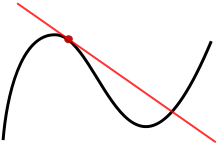微分とは:定義・変化率・接線の傾きとdy/dxの意味
微分の定義から変化率・接線の傾き、dy/dxの意味まで図解と具体例で初心者にもわかりやすく解説。
数学では微分はある量の変化のしかたを定量的に表す概念で、ある点における変化率、すなわち関数がその点でどの程度変化しているかを示します。関数が実数に作用する場合、グラフ上のある点での接線の傾きとして捉えることができます。微分は通常「dy over dx」(yの差をxの差で割ったもの)で表記され、記号としては dy/dx や f'(x)、D[f](x) などが用いられます。dは変数ではないので、打ち消すことはできない、という説明はよく見られますが、後述するように d は演算や微小変化を表す記法としての意味を持ちます。
微分の定義(差分商と極限)
関数 f の点 a における導関数 f'(a) は、次の極限が存在するときに定義されます:
f'(a) = lim_{h→0} (f(a+h) − f(a)) / h.
これは、x を a から微小量 h だけ変化させたときの平均変化率 (差分商) を、h を 0 に近づけることで得られる瞬間的(即時的)な変化率に極限する操作です。極限が存在すればその値が接線の傾きとなり、存在しなければその点では微分可能ではありません。
dy/dx の意味と d の扱い
dy/dx は「y の微小変化量 dy を x の微小変化量 dx で割ったもの」を意味する記法です。厳密には導関数は極限で定義されますが、微分学の計算や応用では dy, dx を「無限小(infinitesimal)あるいは微小変化」として扱うことで便利に扱えます。解析学の形式的な枠組み(例えば微分形式やノンスタンダード解析)では d の意味が整備されています。
注意点:d は単なる変数ではなく、微分演算子(または微小差分の記号)として解釈されます。したがって「d を打ち消す」ことは厳密には正しくありませんが、実務や応用では dx を両辺に掛けるなどして代数的に扱うことが多く、結果的に正しい操作になる場合がほとんどです。
接線の傾きと幾何学的・物理的解釈
関数 y = f(x) のグラフにおける点 (a, f(a)) の接線の傾きは、x の増分が非常に小さいときの y の増分の比として得られます。これは次のようにイメージできます:
- 幾何学的解釈:接線の傾き = グラフを局所的に直線で近似したときの傾き。
- 物理的解釈:位置 x(t) の時間 t による変化であれば、微分 dx/dt は「瞬間速度」を表します。同様に、ある量の時間当たりの変化率としての意味を持ちます。
簡単な例:f(x)=x^2 の微分
例として f(x)=x^2 の導関数を差分商で計算します:
f'(x) = lim_{h→0} ((x+h)^2 − x^2) / h = lim_{h→0} (2xh + h^2) / h = lim_{h→0} (2x + h) = 2x.
したがって、x^2 の微分は 2x であり、点 x=a における接線の傾きは 2a です。
微分可能性と連続性
関数がある点で微分可能であるならば、その点で必ず連続です(微分可能性 ⇒ 連続性)。ただし逆は成り立ちません:連続であっても角や折れ目がある点では微分可能でないことがあります(例:|x| の原点)。
微分の基本的な公式と性質
- 和・差の微分: (f+g)' = f' + g'。
- 積の微分(積の法則): (fg)' = f'g + fg'。
- 商の微分: (f/g)' = (f'g − fg') / g^2(g ≠ 0)。
- 合成関数の微分(連鎖律): (f∘g)'(x) = f'(g(x))·g'(x)。
- 冪関数: (x^n)' = n x^{n−1}(n は正整数。一般化も可)。
高階導関数と応用
一階導関数 f'(x) のさらに微分を取ると二階導関数 f''(x)、さらに高階導関数 f^(n)(x) が得られます。物理では加速度は位置の二階微分(x''(t))に対応します。高階導関数は関数の曲がり具合(凹凸)やテイラー展開における係数と深い関係があります。
線形近似(微分の応用)
微分は関数を局所的に直線で近似するために使われます。点 x=a の近傍で:
f(x) ≈ f(a) + f'(a) (x − a).
この近似は微分を用いた一次近似(線形近似)で、誤差は (x−a) の二乗以上の項に依存します(十分小さい範囲で有効)。
まとめ
微分は関数の局所的な変化率を示す基本的な概念で、接線の傾き、瞬間的な変化速度、関数の局所線形近似など多くの直感的・応用的意味を持ちます。記号 dy/dx は微小変化の比として便利に使われますが、数学的には差分商の極限として厳密に定義されることを忘れないでください。最後に、微分が存在するためには差分商の極限が一意に存在する必要がある点に注意してください。

関数(黒)と接線(赤)。点での導関数は接線の傾きである。
誘導体の定義
xに関するyの微分は、x 0 {displaystyle x_{0}}

f′ ( a ) = lim h → 0 f ( a + h ) - f ( a ) h {displaystyle f'(a)=LIM _{HATTO 0}{FRAC {f(a+h)-f(a)}{h}}} {DISPLAYSTYLE f'(a)=THE LIM _{h}} {FRAC {f(a+h)-f(a)}{HATA
つまり、2つのx点間の距離(h)が0に近づくと、その間の直線の傾きは接線に近くなる。
.gif)
引数が変わると関数の「振り」が変化することで、微分を直感的に理解できるようにしたアニメーションです。
関数の微分
一次関数
一次関数(a x + b {displaystyle ax+b}
従属変数y {displaystyle y}


y {displaystyle y}



電源機能
累乗関数(例:x a {displaystyle x^{a}}
一般に累乗関数は d d x x a = a x a - 1 {displaystyle {dfrac {d}{dx}}x^{a}=ax^{a-1}} という法則に従います。
また、あまり知られていない例として、関数 f ( x ) = 1 x {{displaystyle f(x)={Thinkfrac {1}{x}}}
f ( x ) = 1 x = x - 1 {displaystyle f(x)={Thrac {1}{x}}=x^{-1}}}.
f ′ ( x ) = - 1 ( x - 2 ) {displaystyle f'(x)=-1(x^{-2})} }のようになります。
f ′ ( x ) = - 1 x 2 {displaystyle f'(x)=-{{frac {1}{x^{2}}}}}.
また、根は、その微分を求めることができる分数指数を使用するように変更することができます。
f ( x ) = x 2 3 = x 2 3 {displaystyle f(x)={}sqrt[{3}]{x^{2}}}=x^{prac {2}{3}}} {displaystyle f(x)={}sqrt[{3}]{x^{3}}=x^{prac {2}{3}}=x
f ′ ( x ) = 2 3 ( x - 1 3 ) {displaystyle f'(x)={Chefrac {2}{3}}(x^{-{Chefrac {1}{3}})}} ←クリックすると拡大します。
指数関数
a b f ( x ) {displaystyle ab^{fleft(xxxright)}}






例1
d d x ( a b f ( x ) ) = a b f ( x ) ・ f ′ ( x ) ・ ln ( b ) {displaystyle {frac {d}{dx}}left(ab^{f}left(xright)}}right)=ab^{f(x)}Cdot f'\left(xright)==Cdot ==ln(b)}} {displaystyle}=d{f}{dx}}left(x) {f(x) {f(x)
例2
Find d d x ( 3 ⋅ 2 3 x 2 ) {displaystyle {frac {d}{dx}} left(3Θcdot 2^{x^{2}}}) }
a = 3 {displaystyle a=3}.
b = 2 {displaystyle b=2}.
f ( x ) = 3 x 2 {displaystyle fleft(xright)=3x^{2}}
f ′ ( x ) = 6 x {displaystyle f'\left(x´ω`)=6x} {displaystyle f'⑅right(x´ω`)=6x
そのため
d d x ( 3 ⋅ 2 3 x 2 ) = 3 ⋅ 2 3 x 2 ⋅ 6 x ・ ln ( 2 ) = ln ( 2 ) ⋅ 18 x ⋅ 2 3 x 2 {displaystyle {cfrac{d}{dx}} ◇left(3Cdot 2^{3x^{2}}right)=3Cdot 2^{3x^{2}} ◇6xcdot ◇ln \left(2Cdright)=Cann \lft(2Cdright)18xcdot 2^{3x^{2}}}
対数関数
対数の微分は逆数である。
d d x ln ( x ) = 1 x {displaystyle { {dfrac {d}{dx}} ◇ln(x)={frac {1}{x}}}
例えば、d d x ln ( 5 x ) {displaystyle { {frac {d}{dx}} {ln \left({frac {5}{x}}}right)}
d d x ( ln ( 5 ) )- d d x ( ln ( x ) ){displaystyle {frac {d}{dx}}(\ln(5))-{frac {d}{dx}}(\ln(x))} -{displaystyle {frac {d}{dx}}(\ln(5))
5の対数は定数なので、その微分は0です。ln(x)の微分は、1 x {displaystyle {displac {1}{x}}
0 - d d x ln ( x ) = - 1 x {displaystyle 0-{Afrac {d}{dx}}ln(x)=-{Afrac {1}{x}}}.
d d x ( log 10 ( x ) ) のようにe進数でない対数の導関数については{displaystyle {frac {d}{dx}}(\log _{10}(x))} } のように底eでない対数の微分です。
三角関数
コサイン関数はサイン関数の微分であり、コサインの微分は負のサインである(ただし、xはラジアン単位である)。
d d x sin ( x ) = cos ( x ) {displaystyle {frac {d}{dx}} {sin(x)=Cos(x)} } }.
d d x cos ( x ) = - sin ( x ) {displaystyle {frac {d}{dx}} {cos(x)=-sin(x)} } }.
d d x sec ( x ) = sec ( x ) tan ( x ) {}displaystyle {}frac {d}{dx}}sec(x)=themesec(x)\tan(x)}
誘導体の特性
デリバティブは、(上記の機能特性のうち1つしか持たないため)管理しやすいところで、例えば、分割することができる。
d d x ( 3 x 6 + x 2 - 6 ) {displaystyle {frac {d}{dx}}(3x^{6}+x^{2}-6)}
d d x ( 3 x 6 ) + d d x ( x 2 ) - d d x ( 6 ) {}displaystyle {{frac {d}{dx}}(3x^{6})+{frac {d}{dx}}(x^{2})-{frac {d}{dx}}(6)}} {{frac #d}{dx}{dx}}(3x^{6})-{frac {d}{d}{dx}}(6)
= 6 ⋅ 3 x 5 + 2 x - 0 {displaystyle =6cdot 3x^{5}+2x-0}
= 18 x 5 + 2 x {displaystyle =18x^{5}+2x}
誘導体の用途
関数の導関数は、その傾きがゼロになる場所を探すことで、関数の最大値や最小値を探すことができる。
微分は、関数のゼロ(根)を見つけるのに役立つニュートン法で使用されます。
微分は増減や凹凸を決定できる
関連ページ
質問と回答
Q:導関数とは何ですか?
A:微分とは瞬間的な変化率,つまりある点で関数が変化している量を示す方法です.
Q:一般的にどのように記述するのですか?
A:一般的には「dy over dx」あるいは「dy upon dx」と表記され,yの差をxの差で割ったものを意味します.また,f'(x)という表記もよく使われ,これは点xにおける関数fの微分を意味します.
Q:dは変数ですか?
A:いいえ,dは変数ではありませんし,打ち消すこともできません.
Q:この文脈では,'f'は何を表すのですか?
A: この文脈では,'f'は関数を表している.
Q: この文脈で'x'は何を表すか?
A: この文脈では,'x'はグラフ上の点を表している.
Q: この文脈で'y'は何を表すか?
A:この文脈では,「y」はグラフ上のその点での接線の傾きを表している.
Q:「f'(x)」はどのように読むのですか?A:「f'(x)」は「xのf素数」と読むことができる.
百科事典を検索する






![{\displaystyle f(x)={\sqrt[{3}]{x^{2}}}=x^{\frac {2}{3}}}](https://www.alegsaonline.com/image/e89cba6d130834b88f6ae7b9352db47a9c190e58.svg)














